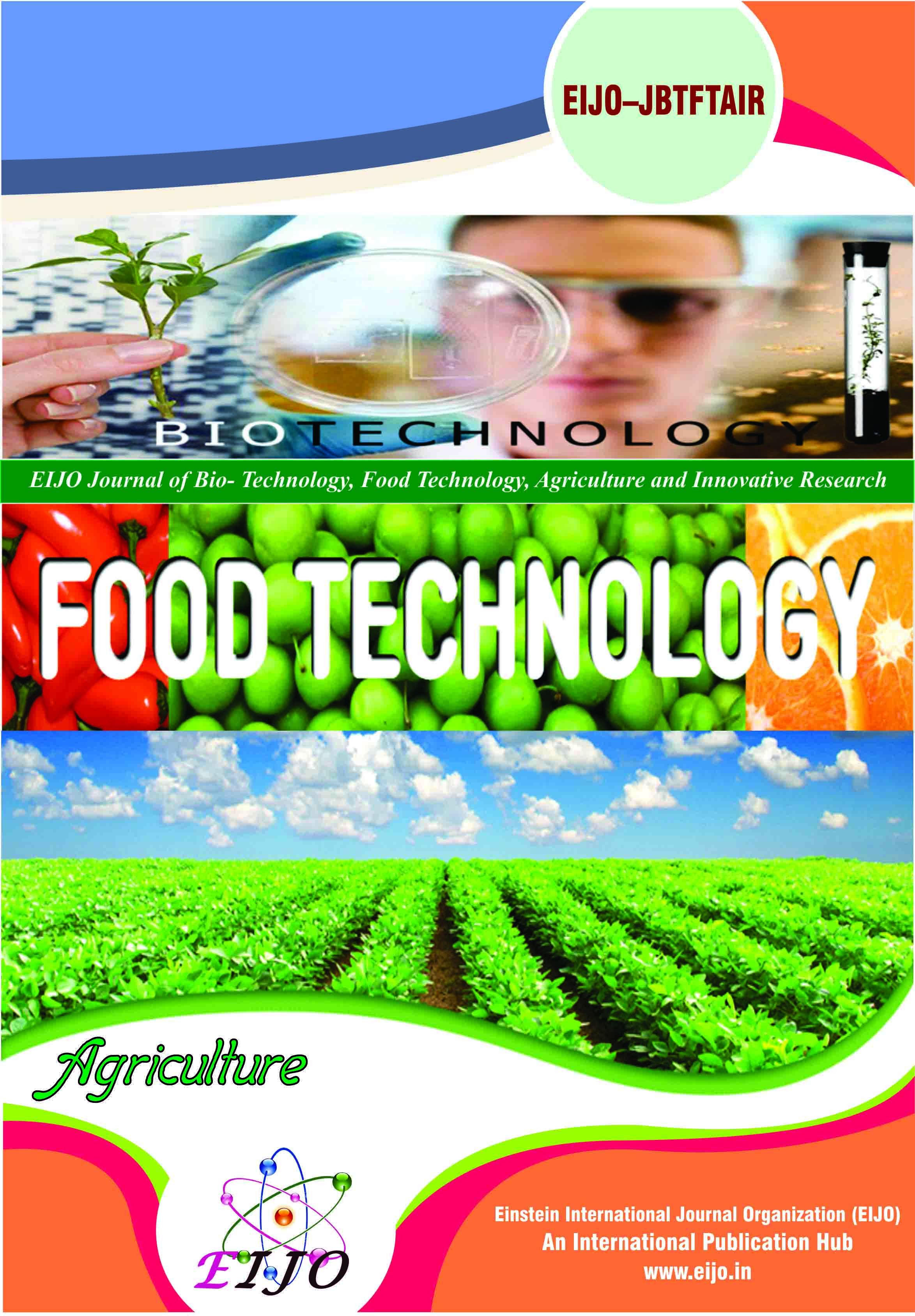JOURNALS || EIJO Journal of Bio- Technology, Food Technology, Agriculture and Innovative Research (EIJO – JBTFTAIR) [ISSN : 2455 - 992X ]
ABSTRACT
The Anemia is an indicator of both poor nutrition and poor health. The most dramatic health effects of anemia, i.e., increased risk of maternal and child mortality due to severe anemia, have been well documented. In addition, the negative consequences of Iron Deficiency Anemia (IDA) on cognitive and physical development of children, and on physical performance particularly work productivity in adults – are of major concern. In order to prevent and combat IDA and in turn enhancing work productivity of the nation, food based approach has played a significant role with less or no side effects. Four food ingredients namely garden cress seeds, black sesame seeds, lotus stem and cauliflower were procured and utilized for preparation of iron rich food products. These developed food products were evaluated for their oganoleptic & nutritional potential. Cheela was found the most acceptable and Idli the least acceptable food product among all four food products developed. Nutritional evaluation depicted that version B of Cheela was found to have maximum amount of iron content among all developed food products.
Key Words: Iron Deficiency Anemia, Iron Rich Food Products, Garden cress seeds, Black sesame seeds, Lotus stem, Cauliflower.
[1]. Food and Agriculture Organization of the United Nations. The state of food insecurity. Washington, DC, FAO, 2006.
[2]. http://www.who.int/nutrition/topics/ida/en.
[3]. R. Yip, “Iron deficiency: Contemporary scientific issues and international programmatic approaches”. J Nutr., 1994, 124(8 Suppl),1479S-1490S.
[4] J. D. Cook and S. R. Lynch, “The liabilities of iron deficiency”, Blood, 1986, 68, 803–9.
[5]. P. R. Dallman, “Iron deficiency and the immune response”, Am J Clin Nutr, 1987, 46, 329–34.
[6]. S. M., Garn, S. A. Ridella, A. S. Petzold, and F. Falkner, “Maternal hematologic levels and pregnancy outcomes”, Semin Perinatol, 1981, 5,155–62.
[7]. M. A. Klebanoff, P. H. Shiono , J. V. Selby, A. I. Trachtenberg, and B. I. Graubard, “Anemia and spontaneous preterm birth”, Am J Obstet Gynecol,1991, 164, 59–63.
[8]. K. A. Harrison, and P. A. Ibeziako, “Maternal anaemia and fetal birth weight” J Obstet Gynaecol Br Cwlth, 1973, 80,798–804.
[9]. G, Nicolas, M. Bennoun, I. Devaux, C. Beaumont, B. Grandchamp, A. Kahn, & S. Vaulont, Proc. Natl. Acad. Sci., 2001, USA 98, 8780–8785.
[10]. Food and Agriculture Organization of the United Nations, World Health Organization, “ Human vitamin and mineral requirements”, Report of a joint FAO/WHO expert consultation, Bangkok, Thailand. Rome, FAO, 2002.
[11]. C. Morón, and F. E. Viteri, “Update on common indicators of nutritional status: food access, food consumption, and biochemical measures of iron and anemia”, Nutrition Reviews, 2009, Vol. 67(Suppl. 1), S31–S35.
[12]. N. S. Scrimshaw, “Functional consequences of iron deficiency in human populations”, J Nutr Sci Vitaminol (Tokyo) 1984, 30:47–63.
[13]. E. R. Monsen, “Iron nutrition and absorption: Dietary factors which impact iron bioavailability”, J. Am. Diet. Assoc., 1988, 88, 786–791.
[14]. http://www.uaex.edu/Other_Areas/publications/PDF/FSA-6084.pdf.
[15]. http://www.agricultureinf ormation.com/forums/medicinal-plants/11013-chandrasur-emerging-medicinal-crop.html.
[16]. K.M. Nadkarni, and A.K. Nadkarni, “In: The Indian Materia Medica with Ayurvedic, Unani and Home remedies”, 3rdedn. Popular Prakashan, Bombay, India, 1954, 736–737.
[17]. R. N. Chopra , S. L. Nayar, and L. C. Chopra LC, “Glossary of Indi an Medicinal Plants (including the Supplement)”, Council of Scientific and Industrial Research, 1986, pp 112 118, New Delhi, India.
[18]. B. M. Ogle, H. T. A. Dao, G. Mulokozi, and L. Hambraeus, “Micronutrient composition and nutritional importance of gathered vegetables in Vietnam”, International Journal of Food Science and Nutrition, 2001, 52: 485-499.
[19]. Z. Q. Ling, B. J. Xie, and E. L. Yang, “Isolation, characterization, and determination of antioxidative activity of oligomeric procyanidins from the seed pod of Nelumbo nucifera Gaertn”, Journal of Agricultural and Food Chemistry, 2015, 53: 2441-2445.
[20]. http://www.biodatabase.de/Cauliflower
[21]. http://www.udc.edu/
[22]. G. V. Senanayake, A. Banigesh, L. Wu, P. Lee, B. H. Juurlink , “The dietary phase 2 protein inducer sulforaphane can normalize the kidney epigenome and improve blood pressure in hypertensive rats”, American Journal of Hypertension, 2012 , 25(2):229-35.
[23]. J. H. Martin, W. H. Leonard, “Miscellaneous industries crops. In: Principles of field crop production”, Macmillan, New York, 1967, pp 922-924.
[24]. G.J. Kapadia, M.A. Azuine, H. Tokuda, M. Takasaki, T. Mukainaka, T. Konoshima and H. Nishino, “Chemopreventive effect of resveratrol, sesamol, sesame oil and sunflower oil in the epstein-barr virus early antigen activation assay and the mouse skin two-stage carcinogenesis”, Pharmacol Res, 2002, 45: 499-505.
[25]. R. V. Cooney, L. J. Custer, L. Okinaka, and A. A. Franke , “ Effects of dietary sesame seeds on plasma tocopherol levels”. Nutr Cancer, 2001, 39(1), 66-71.
[26]. S. M. J. Sirato-Yasumoto Katsuta, Y. Okuyama, and T. Takahashi Ide, “Effect of sesame seeds rich in sesamin and sesamolin on fatty acid oxidation in rat liver”, J Agri Food Chem, 2001; 49: 2647-2651.
[27]. B. Srilakshmi, “Evaluation of food quality”, Food Science, 6th edition, New Age International (P) Ltd. Publishers, New Delhi, 2010.
[28]. N. H. Anderson, “Functional measurement and psychophysical judgment”, Psychological Review, 1970, 77, 153-170.
[29]. https://archive.org/stream/laboratorymethod00otta/laboratorymethod00otta_djvu.txt
[30]. H. Stone, and J. L. Sidel, “Sensory evaluation practices”, 2nd Edition. San Diego, Academic Press, 1992.
[31]. A. Chauhan, and Intelli, “Product development and sensory evaluation of value added food products made by incorporating dried cauliflower green leaves”, J Nutr Food Sci, 2015, 5, 340.
[32]. M. Eddouks, M. Maghrani, and J. B. Michel, “Effect of Lepidium sativum L. on renal glucose reabsorption and urinary TGF B levels in diabetic rats”, Phytotherapy Research, 2008 ;22(1):1-5.
[33]. B. T. Diwakar, P. K. Dutta, B. R. Lokesh, and A. K. Naidu, “Physicochemical Properties of garden cress (Lepidium sativum L.) seed oil. Journal of the American Oil Chemists Society, 2010, 87, 539-548.
[34]. M. Eddouks, M. Maghrani, N. A. Zeggwagh , and J. B.Michel, “Study of the hypoglycemic activity of Lepidium sativum L. aqueous extract in normal and diabetic rats”, Journal of Ethnopharmacology, 2005, 97 (2), 391-395.
[35]. K. R. Kirtikar, and B. D. Basu, “Indian Medicinal Plants”, Popular Prakashan, Allahabad, 2006. pp.174.
[36]. S. M. Beckstrom-Sternberg, and J.A. Duke “The phytochemical database.” Ars genome.cornell.edu/cgi-bin/WebAce/webace?db=phytochemdb. (Data version July 1994a).
[37]. J. M. Jellin, P. Gregory, F. Batz, and K. Hitchens, “Pharmacist’s letter/prescriber’s letter natural medicines comprehensive database. 3rd ed. Therapeutic Research Faculty, Stockton, CA, 2000, p. 1–1527.
[38]. V. E.Tyler, L.R. Brady, and J.E. Robbers, “Lipids. p. 121–122. In: Pharmacognosy. Lea & Febiger, Philadelphia, PA, 1976.
[39]. G. Dark, “On-line medical dictionary”, www.graylab.ac.uk/cgi-bin/omd?sesame+oil. (Data version December 12, 1998).
[40]. G. Annussek, “Sesame oil. In: Gale encyclopedia of alternative medicine”, Gale Group and Looksmart, 2001.
[41].J. Johnson, B.M. Bratt, O. Michel-Barron, C. Glennow, and B. Petruson, “Pure sesame oil vs isotonic sodium chloride solution as treatment for dry nasal mucosa”, Arch. Otolaryngol Head Neck Surg, 2001,127, 1353–1356.
[42]. D. E. Smith, and J.W. Salerno, “Selective growth inhibition of a human malignant melanoma cell line by sesame oil in vitro”, Prostaglandins Leukot. Essent. Fatty Acids, 2001, 46,145–150.
[43]. V. A. Kirsh, U. Peters, S. T. Mayne , A. F. Subar, N. Chatterjee, C. C. Johnson, and R. B. Hayes, “Prostate, lung, colorectal and ovarian cancer screening trial prospective study of fruit and vegetable intake and risk of prostate cancer”, J Natl Cancer Inst, 2007, 1, 99(15), 1200-9.
[44]. World Cancer Research Fund, “Food, Nutrition and the Prevention of Cancer: A Global Perspective,” American Institute for Cancer Research, Washington DC, 1997.
[45]. D. T. H. Verhoeven, R. A. Goldbohm, G. Van Poppel, H.Verhagen and P. A. Van Den Brandt, “Epidemiological Studies on Brassica Vegetables and Cancer Risk,” Can- cer Epidemiology Biomarkers & Prevention, Vol. 5, No.9, 1996, 733-751.
[46] C. B. Ambrosone, S. E. McCann, J. L. Freudenheim, J. R.Marshall, Y. Zhang and P. G. Shields, “Breast Cancer Risk in Premenopausal Women is Inversely Associated with Consumption of Broccoli: A Source of Isothiocy- anates, but Is Not Modified by GST Genotype,” The Journal of Nutrition, Vol. 134, No. 5, 2004, 1134-1138.
[47] P. Brennan, C. C. Hsu, N. Moullan, N. Szeszenia-Dab- rowska, J. Lissowska, D. Zaridze, P. Rudnai, E. Fabiano- va, D. Mates and V. Benckoet, “Effect of Cruciferous Ve- getables on Lung Cancer in Patients Stratified by Genetic Status: A Mendelian Randomisation Approach,” Lancet, Vol. 366, No. 9496, 2005, 1558-1560.
[48] V. A. Kirsh, U. Peters, S. T. Mayne, A. F. Subar, N. Chatterjee, C. C. Johnson and R. B. Hayes, “Prospective Study of Fruit and Vegetable Intake and Risk of Prostate Cancer,” Journal of the National Cancer Institute, Vol 99, No. 15, 2007, 1200-1209.
[49]. M. Traka, “Broccoli Consumption Interferes with Prostate Cancer Progression: Mechanisms of Action,” Acta Hor- ticulturae, Vol. 867, No. 5, 2010, 19-25.
[50]. http://www.njkinnysblog.com
[51]. N. Abbaspour, R. Hurrell, and R. Kelishadi, “ Review on iron and its importance for human health”, J Res Med Sci, 2014, 19(2), 164–174.



